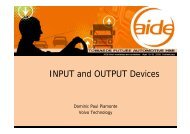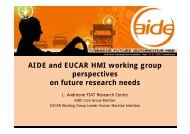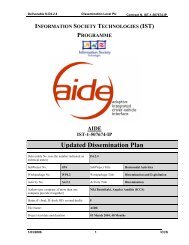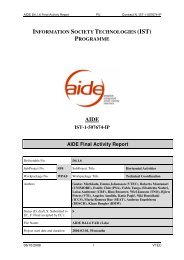download deliverable - AIDE
download deliverable - AIDE
download deliverable - AIDE
Create successful ePaper yourself
Turn your PDF publications into a flip-book with our unique Google optimized e-Paper software.
Deliverable D4.2.1 Dissemination Level PU Contract N. IST-1-507674-IP<br />
only the city (16 button presses). The complex Address Entry task required the entry of both<br />
city and street information (27 button presses).<br />
Twenty-one experienced drivers took part in this experiment. These participants<br />
performed practice trials with similar secondary tasks; 3 baseline drives; 3 drives with<br />
calibration tasks (low, medium and high complexity Circles Task); and 4 drives with the<br />
HASTE visual-manual tasks. Results found that the LCT discriminates lane change path<br />
deviations across the calibration tasks and between different types and complexity of<br />
secondary tasks. These differences are a function of time taken to complete the secondary<br />
tasks so it is essential that task duration is considered within LCT assessments.<br />
Of course more research is needed to validate and refine the LCT procedure and the<br />
procedure would benefit from some criteria on which to set performance limits for unsafe<br />
tasks. Our next step will be to compare these results with the Occlusion Technique and<br />
HASTE, which run multiple studies on the same system and tasks using a variety of driving<br />
performance metrics. The results from this work should be completed before the summer.<br />
3.6.2. Distraction Countermeasures<br />
With respect to distraction countermeasures, Transport Canada has been assessing the<br />
Alliance of Automobile Manufacturers (AAM) “Statement of Principles, Criteria and<br />
Verification Procedures on Driver Interactions with Advanced In-Vehicle Information and<br />
Communication Systems”. Although these principles promise to improve safety, there is<br />
uncertainty on the level of safety and effectiveness of the procedures and criteria. Thus, there<br />
is a need to thoroughly evaluate the AAM’s 24 principles and to measure the compliance of<br />
current in-vehicle devices to these principles as a benchmark for change. Furthermore, there is<br />
a need to evaluate whether the verification procedures are explained in sufficient detail to be<br />
applied effectively. Our study evaluated the compliance of four vehicles to the AAM safety<br />
principles. The Phase 1 static testing will be completed in March 2005 and the Phase 2<br />
dynamic testing will be completed by September 2005. The second phase will concentrate on<br />
AAM Principle 2.1.<br />
This work will provide essential input into the Memorandum of Understanding<br />
(MOU) on Telematics that Transport Canada is currently negotiating with the automotive<br />
industry. A MOU working group was established in November 2004 and has had several<br />
meetings. The working group is comprised of Transport Canada, Canadian Vehicle<br />
Manufacturer’s Association and the Association of International Automobile Manufacturers<br />
of Canada. We are aiming to have an agreement negotiated by early 2006. A central part of<br />
this agreement will be based on a safety management systems approach to the development of<br />
telematics devices to improve the safety of driver-system interaction and reduce the risks of<br />
driver distraction. Currently the most appropriate approach is for manufacturers to ensure that<br />
driver-vehicle integration considerations are systematically addressed within their product<br />
development process. This process based approach would not prescribe steps but would<br />
ensure that manufacturers have the capacity to successfully integrate human factors input into<br />
their design and development process. It would also require comprehensive, systematic and<br />
traceable application of human factors considerations throughout the product development<br />
cycle.<br />
25/07/2005 20 ICCS







